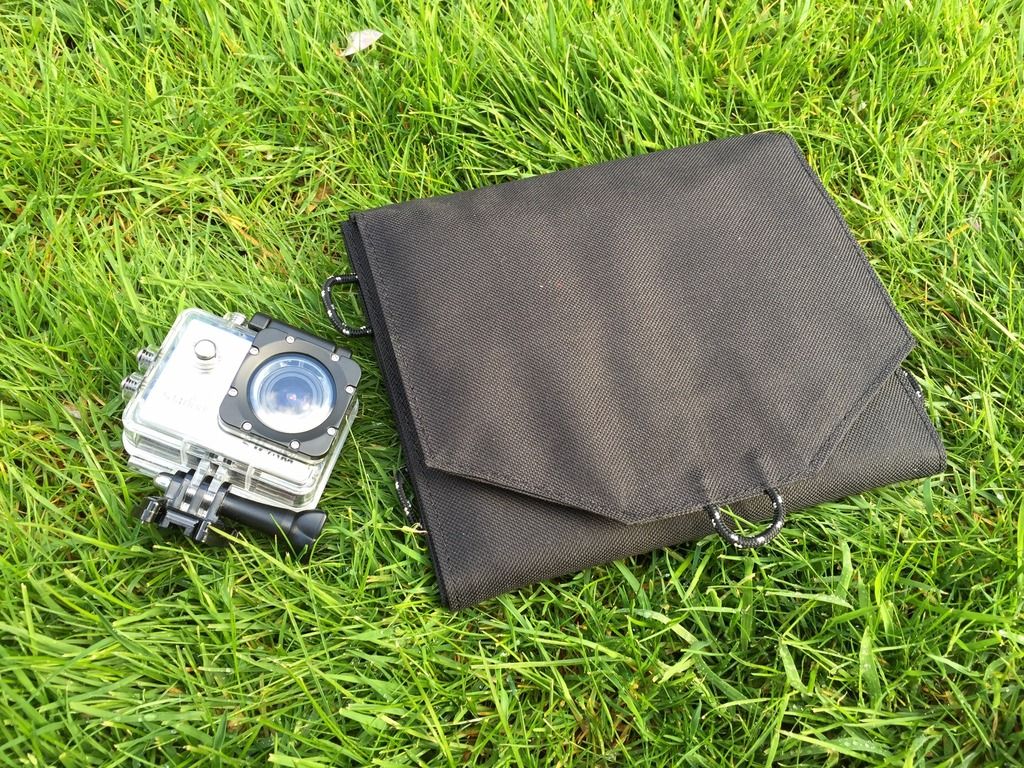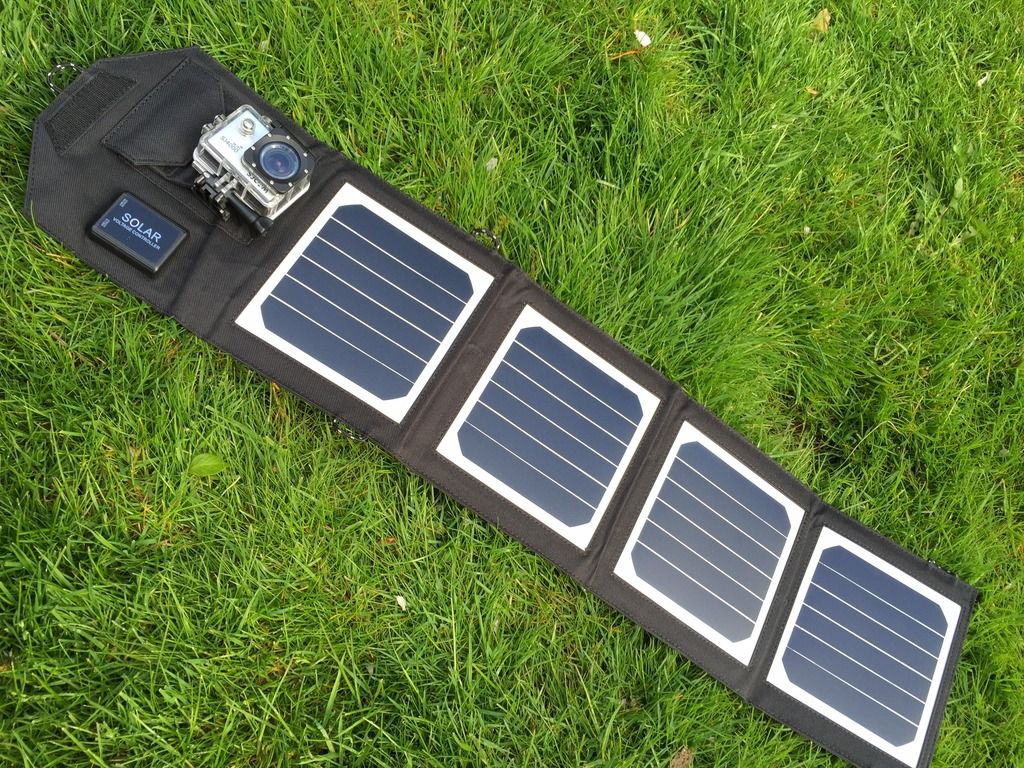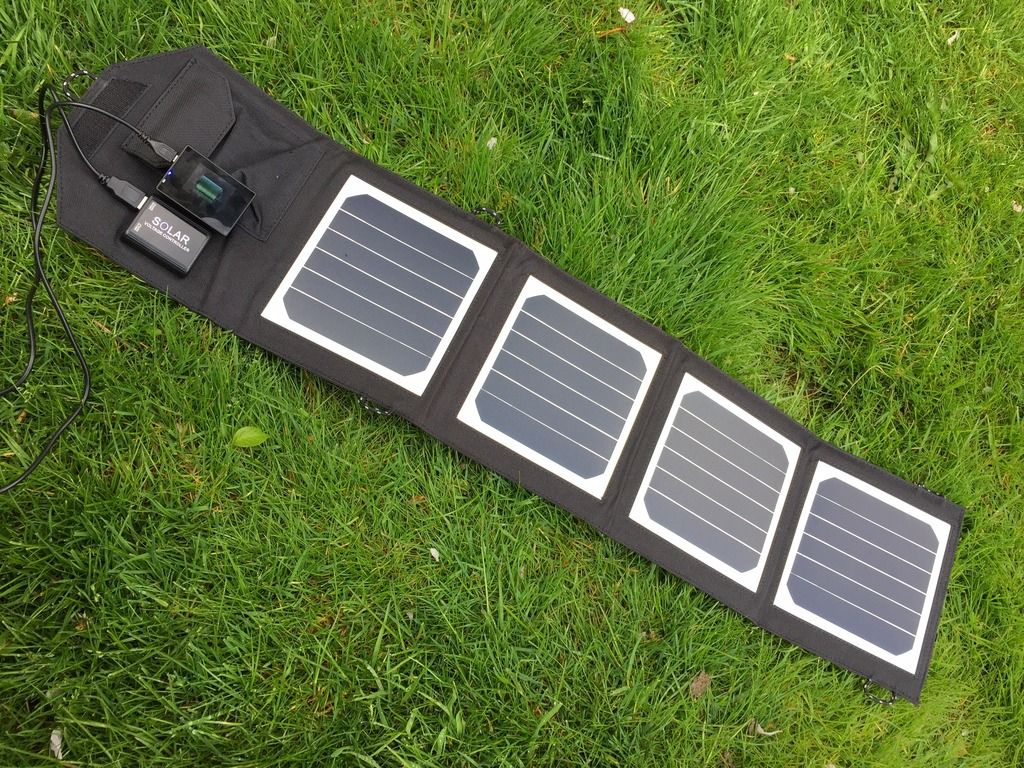As mentioned, Gearbest.com offered me the opportunity to review a few products. The two I asked to try were the SJ4000 action camera and this solar panel, http://www.gearbest.com/mobile-power-bank/pp_144404.html
A long time ago I got a couple of solar panels, the largest being a 10W one. It was quite big, had strange connectors and all in all was more hassle than it was worth. Since then panels have got smaller, cheaper and, for our use, more convenient. The use of USB ports as an almost universal output has really boosted the practicality.
Firstly I know a lot of people are very anti technology and powered products when outdoors as they see it as a distraction from the peace and tranquility. I am largely with you on that, however, i am a big fan of taking pictures and now video as well sharing them here and on Facebook. All this requires power for the phone and cameras, with video being especially battery hungry. Up till now I have generally managed to get by with an external battery bank but I can see this needing topped up on longer trips, which is where my interest in solar panels has come in.
So lets start by talking about this particular solar panel then move onto more general points that will apply to most panels. The details and specification of the panel can be found here, http://www.gearbest.com/mobile-power-bank/pp_144404.html along with the price (currently about £43.00 but if you use the discount code SOLARCHARGER you get about 10% off). The charger is a folding design with four actual solar panels with a total rated output of 14 Watts. Next to the SJ4000 it looks like this

and folded out

Now I'm no electrician, so I enrolled a friend who lectures in electronics and the like (Hi Tony) to do some testing for me and explain some details which I can hopefully convert into plain speak. I am paraphrasing and simplifying as I go along to give the big picture.
The power of solar panels is generally given in Watts. This is calculated by multiplying the voltage (Volts) by the current (Amps). Thankfully for us this is simple, as all USB sockets should output 5 Volts. Your bog standard USB phone charger usually puts out about 2.5 Watts, made up of 5 Volts at 0.5 amps (5V x 0.5A = 2.5W).
So the first thing we tested on this panel was the voltage. Ill spare you the set up details and just tell you that in all but the very darkest conditions we got a consistent 5 Volts (actually about 5.2).

So we can pretty much forget about the voltage. There are two USB ports on the panel. One labelled 2.1 amps and one 2.5 amps. In practice there is no real difference in these; we never got as high as 2 amps. Jumping a bit ahead of myself I can tell you the highest we got was about 1.4 amps. That was in full sun, about 5pm in early May near Glasgow. All of that makes a difference. You would get less power in cloudy conditions, more at midday, more in the middle of summer, less in winter and more further south. The angle of the panel to the sun also makes a difference.
All of the above are why I wanted to try a 14 watt panel. In theory it should be over specified enough that you would still get a useable output in most normal conditions. This indeed proved to be true; in most conditions we were getting at least 0.5 amps and only rarely below 0.25 of an amp.
So what does all this mean in real life? Well as i have said 0.5 of an amp is about the same as a stock phone charger. So with this output your phone would charge just as fast as being plugged into the mains. The SJ4000 only draws about 0.25 amp so charges at full speed in even overcast conditions.

To get the best out of this or any solar panel you need to be aware of this limit on drawing of power. If you have the panel in optimal conditions where it is able to pump out 2 amps and you plug the SJ4000 into it then it only draws 0.25 of an amp and you are missing out on 1.75 amps. A phone will maybe draw 0.5 of an amp, with some we tried drawing 1 amp. An iPad Mini was our goto choice for seeing how high we could go. We suspect it would have taken 2 amps but we never got higher than 1.4 amps. Another factor is that some things will not charge unless they have a certain minimum current. iPhones, in my experience, are particularly choosy this way. Unless they are getting more than 0.5 amps they will not charge at all. So you could have a usable current that is not being drawn and therefore wasted.
The solution to all the above issues is to charge a battery bank. Ideally you want a decent capacity one that will trickle charge with low currents but still be able to charge up to 2 amps. Unfortunately for me, my external battery pack tops out at about 0.5 amps but does charge with even a tiny current of 0.2 amps and less. However this would be wasting a lot of the potential output from this folding solar panel so i am looking at a new battery bank. This set up allows you to connect the battery bank and leave it charging all day while you use your various cameras, phone etc. Then at night you can charge them while you are sitting round the camp fire, or sleeping. The solar charger itself is safe to use in the rain and it is simple enough to rig up some water protection for the battery bank. This way you can have the solar panel either draped over the canoe during the day while paddling between camps or set up at camp whatever the weather. You could also hang it from your rucksack but I've never understood the desire to carry camping equipment on your back in a world that has canoes in it
Another advantage of the battery bank option is it acts as a safety net between the solar panel and your expensive equipment. If something did go wrong with the solar panel and it fried the battery, it would less traumatic than your brand new smartphone giving out smoke signals.
So coming back to the review element of this long post. The panel itself is well made and the electronics do what you want. The voltage is regulated with the current being the part to fluctuate. From the tests we have done I believe the panel is capable of putting out 14 watts of power and in testing in Scottish weather and latitude you still get a useable among of power out. Having had a 10 Watt panel years ago I was frankly stunned at how small and light this panel is. When it arrived I was sure it would not be anything like as powerful as advertised but I was proven wrong and am pleasantly surprised. All in all, I am very impressed with the solar panel. I just need to sort out the right battery bank to have my power needs sorted for my longer trips now.
A long time ago I got a couple of solar panels, the largest being a 10W one. It was quite big, had strange connectors and all in all was more hassle than it was worth. Since then panels have got smaller, cheaper and, for our use, more convenient. The use of USB ports as an almost universal output has really boosted the practicality.
Firstly I know a lot of people are very anti technology and powered products when outdoors as they see it as a distraction from the peace and tranquility. I am largely with you on that, however, i am a big fan of taking pictures and now video as well sharing them here and on Facebook. All this requires power for the phone and cameras, with video being especially battery hungry. Up till now I have generally managed to get by with an external battery bank but I can see this needing topped up on longer trips, which is where my interest in solar panels has come in.
So lets start by talking about this particular solar panel then move onto more general points that will apply to most panels. The details and specification of the panel can be found here, http://www.gearbest.com/mobile-power-bank/pp_144404.html along with the price (currently about £43.00 but if you use the discount code SOLARCHARGER you get about 10% off). The charger is a folding design with four actual solar panels with a total rated output of 14 Watts. Next to the SJ4000 it looks like this

and folded out

Now I'm no electrician, so I enrolled a friend who lectures in electronics and the like (Hi Tony) to do some testing for me and explain some details which I can hopefully convert into plain speak. I am paraphrasing and simplifying as I go along to give the big picture.
The power of solar panels is generally given in Watts. This is calculated by multiplying the voltage (Volts) by the current (Amps). Thankfully for us this is simple, as all USB sockets should output 5 Volts. Your bog standard USB phone charger usually puts out about 2.5 Watts, made up of 5 Volts at 0.5 amps (5V x 0.5A = 2.5W).
So the first thing we tested on this panel was the voltage. Ill spare you the set up details and just tell you that in all but the very darkest conditions we got a consistent 5 Volts (actually about 5.2).

So we can pretty much forget about the voltage. There are two USB ports on the panel. One labelled 2.1 amps and one 2.5 amps. In practice there is no real difference in these; we never got as high as 2 amps. Jumping a bit ahead of myself I can tell you the highest we got was about 1.4 amps. That was in full sun, about 5pm in early May near Glasgow. All of that makes a difference. You would get less power in cloudy conditions, more at midday, more in the middle of summer, less in winter and more further south. The angle of the panel to the sun also makes a difference.
All of the above are why I wanted to try a 14 watt panel. In theory it should be over specified enough that you would still get a useable output in most normal conditions. This indeed proved to be true; in most conditions we were getting at least 0.5 amps and only rarely below 0.25 of an amp.
So what does all this mean in real life? Well as i have said 0.5 of an amp is about the same as a stock phone charger. So with this output your phone would charge just as fast as being plugged into the mains. The SJ4000 only draws about 0.25 amp so charges at full speed in even overcast conditions.

To get the best out of this or any solar panel you need to be aware of this limit on drawing of power. If you have the panel in optimal conditions where it is able to pump out 2 amps and you plug the SJ4000 into it then it only draws 0.25 of an amp and you are missing out on 1.75 amps. A phone will maybe draw 0.5 of an amp, with some we tried drawing 1 amp. An iPad Mini was our goto choice for seeing how high we could go. We suspect it would have taken 2 amps but we never got higher than 1.4 amps. Another factor is that some things will not charge unless they have a certain minimum current. iPhones, in my experience, are particularly choosy this way. Unless they are getting more than 0.5 amps they will not charge at all. So you could have a usable current that is not being drawn and therefore wasted.
The solution to all the above issues is to charge a battery bank. Ideally you want a decent capacity one that will trickle charge with low currents but still be able to charge up to 2 amps. Unfortunately for me, my external battery pack tops out at about 0.5 amps but does charge with even a tiny current of 0.2 amps and less. However this would be wasting a lot of the potential output from this folding solar panel so i am looking at a new battery bank. This set up allows you to connect the battery bank and leave it charging all day while you use your various cameras, phone etc. Then at night you can charge them while you are sitting round the camp fire, or sleeping. The solar charger itself is safe to use in the rain and it is simple enough to rig up some water protection for the battery bank. This way you can have the solar panel either draped over the canoe during the day while paddling between camps or set up at camp whatever the weather. You could also hang it from your rucksack but I've never understood the desire to carry camping equipment on your back in a world that has canoes in it
Another advantage of the battery bank option is it acts as a safety net between the solar panel and your expensive equipment. If something did go wrong with the solar panel and it fried the battery, it would less traumatic than your brand new smartphone giving out smoke signals.
So coming back to the review element of this long post. The panel itself is well made and the electronics do what you want. The voltage is regulated with the current being the part to fluctuate. From the tests we have done I believe the panel is capable of putting out 14 watts of power and in testing in Scottish weather and latitude you still get a useable among of power out. Having had a 10 Watt panel years ago I was frankly stunned at how small and light this panel is. When it arrived I was sure it would not be anything like as powerful as advertised but I was proven wrong and am pleasantly surprised. All in all, I am very impressed with the solar panel. I just need to sort out the right battery bank to have my power needs sorted for my longer trips now.
